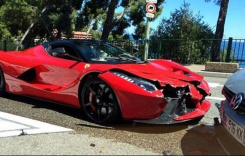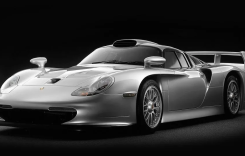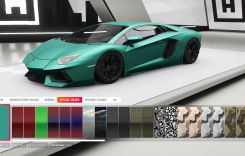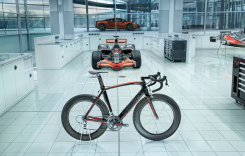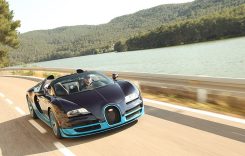
(Top) The SFV650’s display is old in design but functional and we prefer the analog-style tachometer to the digital readouts on the Ducati and Yamaha. (Center) The SFV650 is powered by Suzuki’s tried-and-true 645cc water-cooled V-Twin. The engine is both smooth and peppy with outstanding throttle response. (Below) The Suzuki’s front brake set-up gets the job done however it could stand a boost in feel/lever sensation.
Though its SV650 and Gladius moniker may have changed, Suzuki’s SFV650 ($7699) has long been a staple motorcycle in the Japanese company’s lineup. Featuring a tried-and-true 645cc liquid-cooled V-Twin housed inside a lipstick red tubular steel chassis, the feisty SFV is a great solution for riders looking for a fun, affordable street bike.
Despite being the oldest design, we’re still fond of certain styling elements of the SFV, in particular its sleek exhaust and petite nose. Admittedly though, we wish it offered more modern-looking (and functional) hardware like an inverted fork, radial-mount front brakes and an updated instrument panel.
“The body lines and looks are a little dated, but it’s the only bike in this test that still has an analog tach,” states Colton. “I really like to visibly see where it’s at in the rpm range rather than read the data bars [on the Ducati and Yamaha]”.
Seated at the controls the Suzuki is fairly comfy but has a hair larger wheelbase and feels wider through the mid-section compared to the skinnier Yamaha. The SFV, however, remains more compact-feeling than the larger Ducati. While this is a benefit for some, smaller guys and gals will likely favor the FZ, which also boasts more refined ergonomics with superior proportioning from handlebar, seat and footpegs.
“The Suzuki had the most cramped cockpit,” says our 5’11” tester, Abbott. “The bars swept into your lap and you felt like you kind of had to hunch over to get into the sweet spot of the bike. But on the flip side it was the best cornering of all of them. It felt really connected to the ground. You were able to put the bike where you wanted to and it was the smoothest feeling through the corners and I was most confident on it.”
In the canyons the SFV impressed with sporty handling that was clearly ahead of the competition according to both Abbott and Colton. Even though it weighs 47 pounds more than the featherweight Yammie (but eight under the red bike), the SFV hides its extra mass well, especially in motion. Here it delivers the best of both worlds: pleasing ride quality over bumps, yet a planted and well-connected feel through turns. The chassis also welcomes aggressive riding – more so than the Yamaha, or even the Ducati.
“Of the three the Suzuki was overall the best handling,” agrees AC. “It was supple but it wouldn’t bite you if you gave it too much feedback and overall it felt pretty good.”
As mentioned before the SFV has room for improvement in the braking categories. Although its caliper and master cylinder hardware mirror the FZ-07’s and provide adequate function, they lack the outright stopping power of the Monster, a fact proven by their longest-in-class 143.7-foot stopping distance. While that’s only 3.3 feet behind the Yamaha, it’s 28.7 feet longer than the class-leading Ducati. We also noted the Suzuki as having the least amount of braking feel.

Sport riders will simply love the handling of the SFV. The chassis is easily the most balanced and enjoyable to push on canyon roads.
“The brakes could use a little bit of an update on that motorcycle,” concurs AC. “But, I think it’s a very awesome workhorse for an entry-level Twin.”
We’ve always been fans of the smooth character and peppy response of the SV650/Gladius/SFV’s 90-degree Twin, but like its brakes and ergos, the engine is beginning to show its age.
Dyno testing demonstrates that the SFV offers the least power output at lower revs. Get the engine spinning north of 7500 revs, however, and its powerband eventually eclipses the Yamaha, but is still 12 lb-ft and 27 horsepower less than the mighty Ducati.
And that bottom-end power deficit hurt it in the acceleration testing. Though it gets off the line well due in part to its friendly clutch action and optimum gearing, the Suzuki was still slower than both the Ducati and Yamaha to 60 mph, and again through the quarter-mile. While we like the function of both its clutch and six-speed gearbox it wasn’t quite as precise feeling as the FZ-07’s. It was, however, superior to the Ducati’s set-up.
(Top) Despite rolling on the oldest spec rubber (Dunlop Sportmax Qualifiers) the SFV650 still handled the best. Fit some current spec rubber on it and we’re positive it will be that much more fun to ride. (Center) One of the few strikes against the Suzuki is its more compact rider triangle which favors smaller riders. (Bottom) While we enjoyed riding Suzuki’s SFV, its price tag is a little steep considering the value served up by some of its newly designed competition.
Just like the rev happy Ducati, the SFV performs best with lots of rpm. Keep the tach needle pointed toward the red zone and it actually offers decent get-up-and-go for a small displacement Twin. Despite our propensity for handfuls of throttle the SFV delivered the best fuel mileage registering 46.3 mpg, netting a range of 175 miles based on the 3.8-gallon capacity of its fuel tank.
We’re big fans of its sublime throttle response, feisty engine and exhaust note, but it isn’t quite as thrilling as Yamaha’s playful crossplane Parallel setup, or the Ducati for that matter. Because of its superior throttle response though, it finished ahead of the Monster in the Engine Character department.
“The motor wasn’t really too impressive,” reveals Jason. “But that can be a good thing. Not having enough horsepower lets you really get into the motor and rev it out. It never really got out of control or never got away from you. Not having enough power might not be such a bad thing for someone looking to get into one of these bikes that doesn’t have a whole lot of experience.”

